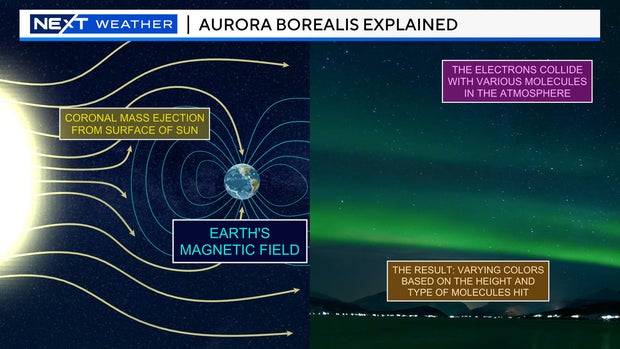Northern lights likely won't be visible again in Massachusetts Friday night
BOSTON - The northern lights once again put on a show in Massachusetts Thursday night. But the chance of seeing them again Friday will be very slim.
You could say New England is becoming the "new Iceland." Over the last several months the sun has been incredibly active, unleashing a series of coronal mass ejections from its surface.
Gallery: Northern lights visible in Massachusetts
The last week or so has been one of the most active periods we have seen in years. For the last several nights, folks have been spotting the northern lights all over New England. The geomagnetic storm responsible for those amazing views is now subsiding.
Severe geomagnetic storm watch
Space weather forecasters issued a "Severe G4 Geomagnetic Storm Watch" for Thursday and the results were spectacular.
Unfortunately, the storm is basically done as it dropped from G4 to G1 overnight. It's unlikely that there will be much if any action Friday night.
What causes the northern lights and aurora borealis?
Meteorologist Jacob Wycoff explained what causes the northern lights earlier this year, when the aurora borealis put on a stunning display in May over the region after a sunspot sent electrons toward Earth.
"What happened is, those electrons, they interacted with our atmosphere," he explained. "And depending on the element and the altitude at which they were interacting with the atmosphere, that's where we got the colors from."
The level of storm activity is measured using something called a "K index." Typically, in order for us in New England to have a shot at seeing auroras we need a K index of 7 or higher.
When that happens (such as Thursday evening) find a location with as little artificial light as possible and with an unobstructed view of the night sky. And, as always, if you snap any pictures we would love to see and share them. Send them to weather@wbztv.com
Sun blast may have ripped comet's tail
Finally, check out this amazing image from a SOHO spacecraft currently orbiting around the sun.
Remarkably, it caught the massive CME AND Comet Tsuchinshan-ATLAS!
Scientists think it is possible that the massive blast from the sun might have ripped off part of the tail of the comet. Time will tell as the comet comes back into view this weekend in the western horizon.






